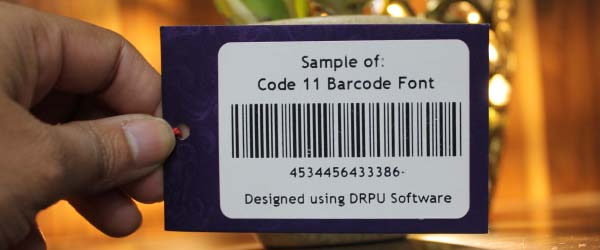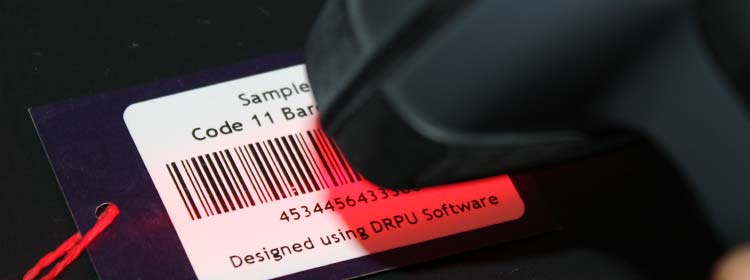CODE 11 Barcode: Length, Advantages and Limitation
Posted By: Techsavvy | Last Updated On:

The Code 11 barcode can encode up to 8 numeric characters, including the hyphen (-) character, and a check digit. The minimum and maximum lengths of a Code 11 barcode depend on the number of characters that are being encoded.
The length of the data field can vary from barcode to barcode, depending on the amount of information that needs to be encoded. The minimum length of the data field is 1 character, while the maximum length is 8 characters.
In addition to the data field, each Code 11 barcode also includes a start character, a stop character, and a check digit. The start and stop characters are always the same - they are represented by the sequence "110". The check digit is a special character that is calculated based on the values of the numeric characters in the data field. The check digit is always the last character in the barcode.
Length of Code 11 barcode can be calculated using the following formula:
Barcode length = (Data field length + 1) * 7 + 6
In this formula, "Data field length" represents the number of numeric characters in the data field, and the "+1" accounts for the hyphen character. The "+6" at the end accounts for the start and stop characters, the check digit, and the stop character.
For example, if the data field contains 4 numeric characters and a hyphen, the length of the barcode would be:
(4 + 1) * 7 + 6 = 35
Therefore, the minimum length of a Code 11 barcode is 13 (1 character in the data field plus the start and stop characters, the check digit, and the stop character), and the maximum length is 35 (8 characters in the data field plus the start and stop characters, the check digit, and the stop character).
It is important to note that the length of the Code 11 barcode is fixed once the data has been encoded. This means that if the data field contains fewer than 8 characters, the remaining spaces must be filled with zeros. For example, if the data field contains only 3 characters, the remaining 5 spaces would be filled with zeros. This is necessary to ensure that the barcode reader can accurately decode the barcode.
You may also like: CODE 11 Barcode: Generate, Connect, Scan and Print?
Code 11 is a type of barcode symbology that can only encode numeric characters. It is capable of encoding the numbers 0-9, as well as the special character hyphen (-). The hyphen is often used as a separator between two groups of digits, and is included in the total character count.
Each numeric character is represented by a set of two bars and three spaces, with varying widths. The widths of the bars and spaces can be different for each character, and are used to differentiate between different digits.
To calculate the check digit, the values of the numeric characters in the data field are added together, starting from the rightmost digit. Each digit is multiplied by a weight factor, which is determined by its position in the data field. The weight factors for Code 11 are as follows:
Position: 7 6 5 4 3 2 1
|Weight: 1 2 3 4 5 6 7
After multiplying each digit by its weight factor, the products are summed together. The check digit is then calculated as follows:
Check digit = (11 - (sum mod 11)) mod 11
In this formula, "sum" represents the sum of the products calculated in the previous step, and "mod" represents the modulo operator. If the value of the check digit is 10, it is represented by the special character "X".
For example, if the data field in a Code 11 barcode contains the number "1234", the check digit would be calculated as follows:
1 * 7 + 2 * 6 + 3 * 5 + 4 * 4 = 49
Check digit = (11 - (49 mod 11)) mod 11 = 9
Therefore, the complete barcode would be "1234-9".
Important NOTE:
It is important to note that Code 11 does not include any lowercase or uppercase letters, symbols, or other special characters. It is strictly limited to the numbers 0-9 and the hyphen character. If other types of information need to be encoded, other barcode symbologies may be more suitable.
One important feature of Code 11 is the use of a check digit. The check digit is a special character that is calculated based on the values of the numeric characters in the barcode. It is used to detect errors that may occur during the transmission or scanning of the barcode.
Code 11 barcodes are read and decoded using barcode scanners or readers, which are specialized devices that use light sensors to capture the barcode image and interpret its contents.
When a Code 11 barcode is scanned, the scanner emits a beam of light, usually a red laser, which is directed at the barcode. The light reflects off the barcode and is picked up by the scanner's sensors. The sensors measure the intensity of the reflected light at each point on the barcode, and convert the light pattern into an electrical signal.
This electrical signal is then processed by the scanner's decoder, which interprets the pattern of bars and spaces to determine the encoded data. The decoder analyzes the width and spacing of each bar and space to identify the individual characters in the barcode, and then applies the appropriate encoding rules to translate these characters into their numeric values.
Once the data has been decoded, the scanner typically transmits the information to a computer or other electronic device via a wired or wireless connection. This allows the scanned data to be stored, analyzed, or used in other applications.
One key feature of Code 11 barcodes is the use of a check digit. As mentioned earlier, the check digit is calculated based on the values of the numeric characters in the barcode, and is used to detect errors that may occur during the scanning or transmission of the barcode. When a scanner reads a Code 11 barcode, it calculates the check digit based on the values of the other characters in the barcode, and then compares the calculated check digit to the check digit that is encoded in the barcode. If the two values do not match, it indicates that an error has occurred.
To avoid errors when reading Code 11 barcodes, it is important to use a high-quality scanner that is capable of accurately measuring the width and spacing of the bars and spaces. The scanner should also be properly calibrated to ensure that it is able to detect subtle differences in the reflected light that could indicate variations in the width or spacing of the barcode elements.
In addition, it is important to ensure that the barcode is printed correctly, with sufficient contrast between the bars and spaces and without any smudging, blurring, or other defects that could interfere with the scanner's ability to read the barcode. Finally, it is important to ensure that the barcode is positioned correctly within the scanner's field of view, and that the scanner is held steady and pointed directly at the barcode.

Code 11 barcodes provide a reliable and cost-effective solution for a wide range of applications. Their high data density, wide character set, and error detection capabilities make them a popular choice for inventory tracking, shipping and logistics, and other applications where data accuracy and reliability are critical.Code 11 barcodes have a number of advantages over other barcode types, including:
Code 11 barcodes can encode a large amount of data in a relatively small space. This makes them ideal for applications where space is limited, such as on small products or packaging.
Code 11 barcodes can encode both numeric and special characters, including hyphens and dollar signs. This allows them to be used in a variety of applications, from inventory tracking to shipping and logistics.
Code 11 barcodes can be printed using a variety of printing technologies, including inkjet, laser, and thermal printers. This makes them accessible to a wide range of users and applications.
Code 11 barcodes are designed to be highly readable, even in low light or poor quality printing conditions. This makes them ideal for use in environments where lighting and printing conditions may not be optimal.
Code 11 barcodes include a check digit that is used to detect errors that may occur during the scanning or transmission of the barcode. This ensures that the data encoded in the barcode is accurate and reliable.
Code 11 barcodes are recognized as an international standard by the International Organization for Standardization (ISO), which ensures that they can be used globally and across industries.
Code 11 barcodes are relatively inexpensive to produce, and can be printed on a wide range of materials, including paper, plastic, and metal. This makes them an affordable option for small businesses and individual users.
Code 11 barcodes can be used to encode confidential or sensitive information, such as financial data or medical records. Because the barcode data is not visible to the naked eye, it provides an additional layer of security for sensitive information.
Code 11 barcodes can be used in a variety of applications, including inventory tracking, shipping and logistics, healthcare, and retail. They can also be used in combination with other barcode types, such as Code 128 or UPC, to provide additional data encoding and compatibility.
Code 11 barcodes can be read by a wide range of barcode scanners and readers, making them compatible with a variety of systems and applications.
You may also like: CODE 11 Barcode
Code 11 barcode is a relatively simple barcode that is primarily used for labeling telecommunication equipment, electronic components, and industrial products. While it has some advantages, it also has some limitations that need to be considered.
Code 11 can only encode the numbers 0 to 9 and the dash symbol ("-"). This means that it cannot be used to encode letters or other special characters.
Code 11 is primarily used in the telecommunications and electronics industries. It may not be suitable for other types of products or applications.
Since Code 11 can only encode numbers and the dash symbol, it is not suitable for encoding other types of data, such as text or binary data.
Code 11 is not as widely used as other barcodes, such as Code 128 or QR codes. This can make it more difficult to find hardware and software that supports it.
Code 11 does not include built-in error correction, which means that it is more susceptible to errors caused by printing, scanning, or data transmission issues.
Code 11 does not include any human-readable characters, which can make it difficult for users to verify that the correct data has been encoded.
Code 11 has a relatively low density compared to other barcodes. This means that it requires more space to encode the same amount of information as other barcodes, which can be a problem if label space is limited.
Code 11 does not include any built-in security features, such as encryption or authentication. This means that anyone with a scanner can read the barcode and access the encoded data.
In summary, Code 11 is a simple barcode that is useful for encoding numeric data in certain industries, but it has limitations when it comes to density, character set, error correction, and security. Before choosing Code 11 for a labelling application, it is important to consider these limitations and evaluate whether it is the best option for the specific use case.